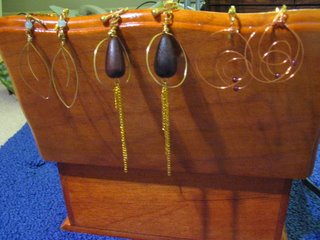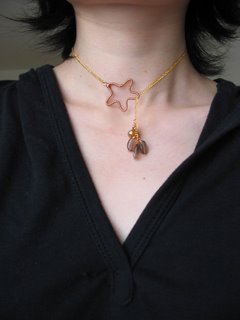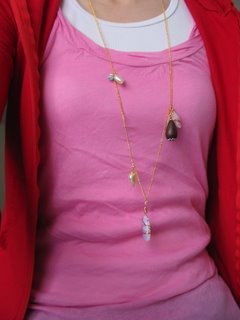How often have you seen something being sold for an arm and a leg and thought, "I could make that myself"? The answer probably varies from person to person, but it's safe to say that it has occured a handful of times for most people. That's pretty much how I fell into jewelrymaking. I saw a necklace that was "on sale" for $30; I went home and made my own version for about $3.
I think jewelrymaking is one of the more accessible crafts, with plenty of room for personal growth so that the hobby never gets boring. Beginners can start by stringing beads on a string, then move up to wire-wrapping, maybe even graduating to metalsmithing. However, I think the best part of jewelrymaking is near-instant gratification: if it's a simple project, you'll be able to make something wearable within minutes. If it's a long project, you can put it aside and pick it up again whenever you want; once you resume your project, you'll be able to finish fairly quickly. Jewelrymaking might also benefit you financially. If you're the type of person who is really into buying and wearing accessories, you can save a ton of dough by making your own, exactly the way you like it. Your pocketbook will also thank you come holidays/birthdays. When you make jewelry as gifts for family and friends, you have the added benefit of making your gift recipients feel extra-special because of your personal touch in making something just for them. If you get good enough at it, there's the possibility that a simple hobby can turn into a revenue-generating enterprise, and who doesn't like extra cash? There are other intangible benefits as well. Believe it or not, stringing beads through a string can be very relaxing. Making jewelry was what got me through the past semester, when I was sick and tired all the time. Besides, it gives you a creative outlet and works that right side of the brain, and you'll be filled with a sense of pride that you've created wearable art.
As with any good thing, there are strings attached. The big downside is the potential of runaway expenses, primarily in the startup costs. A cheap set of tools you'll need to get started generally runs between $10-20. As you advance, you'll probably need to replace them with a more precise set. You'll also need stringing materials, which can become expensive. You'll need lots of findings (metal components). Base metal varieties are fairly cheap but can add up when you need a variety of them. If you want precious metal findings (gold, gold-filled, pure silver, or sterling silver), they can be very expensive. However, in my opinion, the greatest expenses are attributed to beads. You want lots of them, and you want lots of different kinds. In order to have more intriguing designs, you'll need a variety of beads; it's hard to be inspired when you only have a pile of brown and a pile of black. You'll need lots of beads because they get used up quickly for necklaces, bracelets, etc. Wood and plastic beads are the cheapest, but if you want to make things that are more sophisticated, you may need to buy fancy glass beads (i.e. Murano), gemstone beads, and Swarovski crystals, which cost more (and in some cases, a lot more). All in all, I spent about $150 procuring my beginner set of tools and starting batch of gemstones, glass beads, and findings.
Fortunately, the benefits generally outweigh the costs, and there are means to keep it that way. The starting costs are a lot, but you can make so much out of it. Here's just some of what I was able to make. I've made so many baubles (and gave some away) that it's impossible to show them all.
The newbie-ish funky earrings:

Something more sophisticated:

Ring-a-ling-dings...

...and a few of my favorite things:



Although my starting materials cost me $150, the end products are probably worth several times over. Now that I make my own stuff, I realize that most of the cost of jewelry is based on labor. Certain pieces (like the black beaded necklace above) can take several hours to make. I certainly understand that jewelry artists need to make a living, so they have no choice but to charge a lot, but for those of us who don't have that kind of money but still want the "luxury," making our own is the only way to get it. Aside from labor, materials cost money, though sometimes the markup isn't justfied by the quality. It's ridiculous to pay $60 for something made of cheap plastic, even if it is one-of-a-kind. In that case, making your own is the way to go. For anything gold-filled and sterling-silver, the savings from DIY are even more pronounced. While precious metal jewelry tend to be more expensive, sterling silver and gold-filled findings are still very affordable. A foot-long sterling chain can be purchased for several dollars per foot from a jewelry supplies store, and all you have to do is to pay pennies for clasps to attach to the ends, add on a few charms for a couple bucks each, and you've got yourself a trendy necklace. If you buy the same necklace in a store, the markup is significantly higher (try anywhere between 3-10X). Note that sterling silver is an alloy (92.5% silver), not fine silver, and gold-filled is somewhat of a misnomer. There's more gold than gold-plated because several layers of gold are chemically bonded to the surface of the wire (usually with a copper core), so it looks better but doesn't cost as much as a real gold chain.
Next: now that I've explained why DIY can save money, stay tuned for the how.

2 comments:
very beautiful items.
Thanks!
Post a Comment